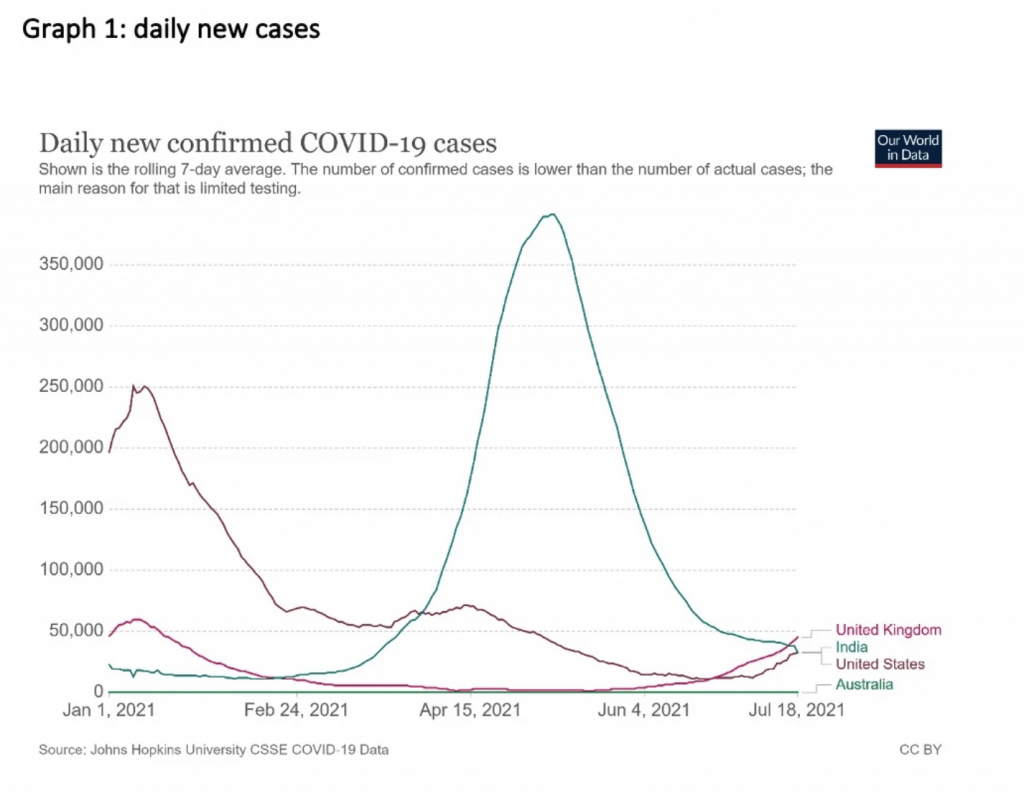According to the World Health Organization, as of 16 July, more than 180 million people have been infected with COVID-19, four million of whom died. There were more than half a million new cases on Monday this week.
The blizzard of COVID information (and misinformation) in the old and new media makes it hard to see the wood for the trees.
Two graphs can help us see where we are and point to our successes, failures, and risks.

Australia’s response to COVID cases to date has been a stand-out success.
Due to tough action by the Federal Government in imposing external border controls early, and by the states in implementing lockdowns and internal border closures – despite opposition from the Federal Government – Australia has maintained very low rates of COVID infections compared to the United Kingdom and the United States.
But the daily new cases graph shows that the pandemic is nowhere near over, with cases beginning to rise again in many countries, including in the UK and the US.
The more infectious Delta strain is becoming the dominant strain in many countries, with population vaccination levels too low to prevent spread.

Foolhardy complacency
Australia’s performance does not look so good on graph 2: the proportion of the population fully vaccinated.
The thesaurus of descriptors of our vaccine rollout performance includes train wreck, schemozzle, political, and botched.
We were slow to start, and we’ve progressed slowly since then.
Together the two graphs highlight why Australia should not make the mistake the UK has made by rushing to a ‘Freedom Day’ – that is, easing or abandoning restrictions before a sufficient proportion of the population is vaccinated.
Graphs 1 and 2 together show that Australia was good on controlling the spread of coronavirus and bad on vaccinations – and that the UK was the mirror image.
Australia’s complacency, prompted by our success in controlling the spread, turned out to be foolhardy.
Taiwan and New Zealand appear to be suffering from the same mix of low rates and slow rollout.
The UK had high rates of daily new cases at the start of this year, which dropped towards the middle of the year before increasing again.
Despite only about half the UK population being fully vaccinated, Prime Minister Boris Johnson pushed on with a reckless opening up strategy – ‘Freedom Day’, when clubs and pubs reopened and restrictions were lifted, was 17 July.
This dangerous strategy, implemented when daily new cases were in excess of 50,000, is likely to lead to daily new cases increasing above 100,000 in the next month or so.
Lessons to heed
The lesson for Australia is do not listen to the siren calls of those who do not care about humans and their health, and urge opening up too soon. Opening up while the virus rampages will be bad for both the economy and health.
Australia, indeed, all countries, should open up only when the virus is under control and vaccination rates are high.
Even after opening up, some public health measures will need to remain in place (for example, masks on public transport).
Graph 1 also shows the Indian tragedy. India reached a peak of more than 350,000 daily new cases in the middle of this year. When the virus spreads rapidly, mutations are more likely. The Delta variant was first identified in India in October 2020.
A global imperative
Uncontrolled spread of the virus in any country is a risk to all. The next dominant variant will be more transmissible and potentially more severe, and so it is a global imperative to control the virus everywhere.
Graph 2 shows the very low rates of vaccination in Africa.
Despite the good work of the COVID-19 Vaccines Global Access (COVAX) Facility, vaccine supply is grossly inequitable – less than one percent of people in low-income countries have been vaccinated. This is a potential risk for every country.
Although Australia is in a good place right now – despite difficult lockdowns in NSW, Victoria, and South Australia – we should not be complacent.
We need to get our vaccination rates up and help other countries to do the same.
While you’re here…
Grattan Institute is an independent not-for-profit think tank. We don’t take money from political parties or vested interests. Yet we believe in free access to information. All our research is available online, so that more people can benefit from our work.
Which is why we rely on donations from readers like you, so that we can continue our nation-changing research without fear or favour. Your support enables Grattan to improve the lives of all Australians.
Donate now.
Danielle Wood – CEO
